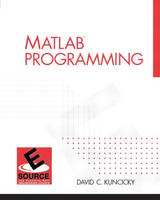
MATLAB Programming
Pearson (Verlag)
978-0-13-035127-2 (ISBN)
- Titel ist leider vergriffen;
keine Neuauflage - Artikel merken
For Freshman or Introductory courses in Engineering and Computer Science.
ESource—Prentice Hall's Engineering Source—provides a comprehensive, customizable introductory engineering and computing library. Featuring over 25 modules and growing, ESource allows professors to fully customize their textbooks through the ESource website. Professors are not only able to pick and choose complete modules, but also custom-build a freshman engineering text that matches their content needs and course organization exactly! Using the ESource online BookBuild system at www.prenhall.com/esource, they can view and select book chapters, change the sequence, instantly calculate the book's net (bookstore) price, request a free examination copy, and generate an ISBN for placing a bookstore order. They can also add your own course notes, syllabi, reference charts, or other favorite materials, including material from third-party publishers. ESource Access Card: 0-13-090400-7. Include this ISBN when setting up an ESource Bundle.
David C. Kuncicky is a native Floridian. He earned his Baccalaureate in psychology, Master's in computer science, and Ph.D. in computer science from Florida State University. He has served as a faculty member in the Department of Electrical Engineering at the FAMU-FSU College of Engineering and the Department of Computer Science at Florida State University. He has taught computer science and computer engineering courses for over 15 years. He has published research in the areas of intelligent hybrid systems and neural networks. He is currently the Director of Engineering at Bioreason, Inc. in Sante Fe, New Mexico.
1. Introduction.
Orientation to the Text. Introduction. Typographic Conventions Used in the Text. Problem Solving and the Engineering Method. The MATLAB System. Introduction to Computing.
2. The MATLAB Interactive Environment.
The MATLAB Desktop. Creating, Editing and Saving Sessions. Importing and Exporting Data. Printing. Getting Help. Setting Preferences.
3. The Programming Elements of MATLAB.
Introduction. Data Storage. Operators and Expressions. Names. Program Organization.
4. Control Structures.
Introduction. Pseudocode. Flowcharts. Selection Statements. Repetition Statements.
5. Arrays and Matrix Operations.
The Primary MATLAB Data Structure. Entering Arrays and Matrices. Accessing and Manipulating Array Elements. Element-by-Element Array Operations. Binary Matrix Operations. Unary Matrix Operations. Multidimensional Arrays. Useful Array Functions.
6. Plotting and Graphing.
Introduction. The plot Command. Using the Plot Editor. Line and Marker Styles. Labeling a Plot. Multiple Plots. Scaling a Plot.
7. Procedural Abstraction.
The Procedural Paradigm. Defining and Using Functions. Types of Variables. Parameter Passing. Functions with Limited Scope. Name a Resolution. Functions as Arguments.
8. Recursion.
Introduction. A Simple Recursion Example. Stack-Based Explanation. Designing a Recursive Solution. Types of Recursion. When to Use Recursion.
9. Introduction to Object-Oriented Programming.
The Object-Oriented Paradigm. Object-Oriented Elements and Mechanisms. Defining Classes in MATLAB. Instantiating Objects in MATLAB. An Sample Class. Encapsulation.
10. Software Development.
Introduction. Software Reliability. Software Efficiency. Interfacing with Other Languages.
| Erscheint lt. Verlag | 16.10.2003 |
|---|---|
| Sprache | englisch |
| Maße | 254 x 203 mm |
| Gewicht | 503 g |
| Themenwelt | Mathematik / Informatik ► Informatik ► Theorie / Studium |
| Mathematik / Informatik ► Mathematik ► Angewandte Mathematik | |
| Mathematik / Informatik ► Mathematik ► Computerprogramme / Computeralgebra | |
| ISBN-10 | 0-13-035127-X / 013035127X |
| ISBN-13 | 978-0-13-035127-2 / 9780130351272 |
| Zustand | Neuware |
| Informationen gemäß Produktsicherheitsverordnung (GPSR) | |
| Haben Sie eine Frage zum Produkt? |
aus dem Bereich


